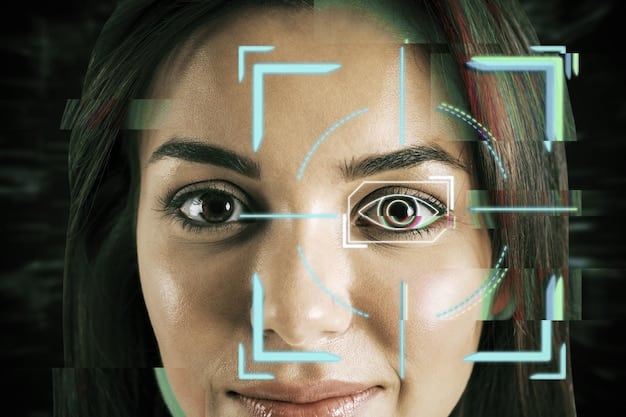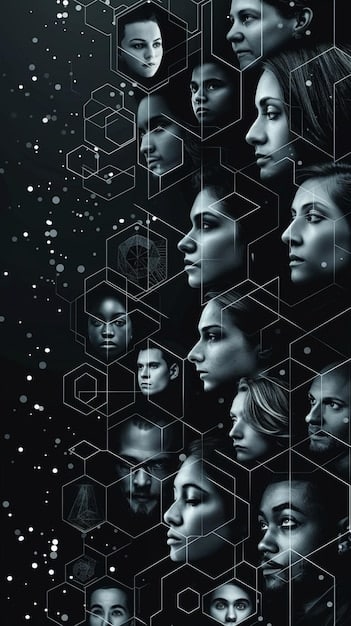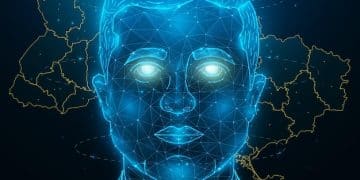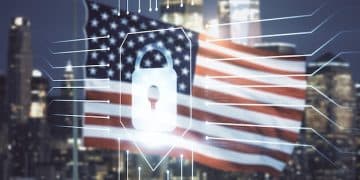Ethical implications of facial recognition in US law enforcement

Exploring the ethical implications of facial recognition technology in U.S. law enforcement reveals profound concerns regarding privacy, civil liberties, and potential biases, demanding a careful balance between security and individual rights.
The burgeoning deployment of facial recognition technology by law enforcement agencies across the United States has ignited a fierce debate concerning its ethical implications. As this powerful technology becomes more pervasive, understanding what are the ethical implications of facial recognition technology in law enforcement in the US becomes paramount for policymakers, civil rights advocates, and the public alike.
the privacy vs. security dilemma
The core of the ethical debate surrounding facial recognition in law enforcement lies in the fundamental tension between public security and individual privacy rights. Proponents argue its utility in identifying suspects, locating missing persons, and preventing crime, thereby enhancing communal safety. However, critics contend that its widespread use risks transforming public spaces into perpetual surveillance zones, eroding democratic freedoms.
The concept of “reasonable expectation of privacy” in public has been historically challenging to define, but facial recognition pushes its boundaries further. Unlike traditional surveillance cameras that might capture images, facial recognition actively processes biometric data, turning an anonymous face into a digital identifier linked to extensive personal information. This shift from passive observation to active identification raises significant ethical questions about consent and freedom from unwarranted scrutiny.
data collection and storage concerns
The sheer scale of data collection by facial recognition systems is staggering. Law enforcement agencies often access vast databases, including driver’s license photos, social media images, and even mugshot databases. The ethical concerns multiply when considering how this data is stored, who has access, and for how long it is retained. Without robust safeguards, the potential for misuse or data breaches is significant.
- Privacy erosion: Continuous monitoring can lead to a chilling effect on free speech and assembly.
- Data security risks: Centralized databases are vulnerable to cyberattacks and unauthorized access.
- Function creep: Data collected for one purpose might be used for others without consent.
Furthermore, the indefinite storage of facial data raises questions about the long-term implications for individuals. A person’s historical movements and interactions could be meticulously reconstructed, creating a digital footprint that follows them indefinitely. This raises concerns about the potential for future profiling or discrimination based on past activities, irrespective of their legality or relevance.
The lack of a transparent and uniform legal framework governing the collection, storage, and use of facial recognition data across all jurisdictions in the US complicates matters. This patchwork approach leads to inconsistencies and leaves citizens vulnerable, as their privacy rights may vary depending on their location. Addressing these issues requires comprehensive national legislation that prioritizes individual liberties while acknowledging legitimate security needs.
Ultimately, the balance between security and privacy is precarious. While facial recognition offers potent tools for law enforcement, its deployment must be accompanied by strict ethical guidelines and robust legal frameworks to prevent abuses and protect the fundamental rights of citizens.
bias and discrimination

One of the most pressing ethical concerns surrounding facial recognition technology is its documented propensity for bias, particularly against marginalized communities. Studies have consistently shown that these systems are less accurate in identifying individuals who are women, people of color, and older adults, leading to a higher likelihood of misidentification and false arrests.
This algorithmic bias is not inherent to the technology itself but is a reflection of the datasets used to train these systems. If training data lacks diversity, the system will perform poorly when encountering faces outside the predominant demographic. In a society grappling with historical injustices and systemic inequalities, deploying biased technology in law enforcement risks exacerbating existing disparities and eroding trust between communities and police.
disparate impact on minority groups
Flawed facial recognition technology can have a disproportionate impact on minority communities. A false match could lead to wrongful accusations, arrests, and even convictions, creating significant personal and societal damage. The consequences extend beyond individual cases, potentially fostering a sense of mistrust and alienation from law enforcement among already vulnerable populations.
- Higher false match rates: Increased risk of misidentification for women and people of color.
- Exacerbation of existing biases: Amplifies racial and gender profiling by law enforcement.
- Erosion of trust: Damages community relations and willingness to cooperate with police.
The ethical imperative here is clear: technology used in law enforcement must be demonstrably fair and unbiased. Relying on systems known to perpetuate or amplify existing societal biases is not only unethical but also counterproductive to the goals of equitable justice. Agencies must critically evaluate the accuracy of these systems across all demographics and refrain from deployment where biases are evident.
Moreover, the concept of “predictive policing” — where facial recognition is combined with other data to anticipate future criminal activity — introduces another layer of ethical complexity. If the underlying data or algorithms are biased, such systems could unfairly target certain neighborhoods or demographic groups, effectively criminalizing individuals based on flawed predictions rather than concrete evidence of wrongdoing. This raises serious questions about due process and civil liberties.
Addressing bias requires a multi-faceted approach, including diverse training datasets, independent audits of algorithmic fairness, and robust legal oversight. Without these measures, facial recognition technology risks becoming another tool for perpetuating systemic injustice rather than a neutral instrument for enhancing public safety.
lack of transparency and accountability
A critical ethical concern is the pervasive lack of transparency surrounding how law enforcement agencies acquire, deploy, and utilize facial recognition technology. Many agencies operate with little public oversight, making it difficult for citizens, civil rights organizations, and even elected officials to understand the scope and impact of these surveillance tools. This opacity hinders accountability and makes it nearly impossible to address potential abuses or systemic errors.
The proprietary nature of many facial recognition algorithms also contributes to this lack of transparency. Vendors often guard their source code as trade secrets, preventing independent scrutiny of their accuracy, biases, and underlying methodologies. Without this ability to “look under the hood,” the public is forced to trust that these powerful systems are operating fairly and reliably, a trust that is often unwarranted given the documented issues.
absence of clear policies and oversight
Many jurisdictions lack clear, comprehensive policies governing facial recognition use. This vacuum allows agencies to develop their own internal guidelines, which may vary wildly and often fall short of robust ethical standards. The absence of legislative oversight means there’s no consistent framework to ensure that the technology is used responsibly and within the bounds of constitutional rights.
- Informal deployments: Agencies often use the technology without public knowledge or consent.
- No public auditing: Difficult to verify the accuracy or fairness of the systems in use.
- Limited recourse: Individuals have little ability to challenge misidentifications or abuses.
The ethical problem deepens when considering who is held accountable when a facial recognition system makes an error. Is it the officer who used the system, the analyst who interpreted the results, or the vendor who developed the technology? Without clear lines of responsibility, the path to justice for those wronged by the technology becomes obscured. This environment fosters a culture where mistakes and biases can go uncorrected, leading to repeated harm.
Furthermore, the rapid evolution of this technology often outpaces regulatory efforts. By the time legislation is even considered, new capabilities and applications have emerged, creating a perpetual game of catch-up. This technological dynamism underscores the need for proactive and adaptable governance frameworks that anticipate future challenges rather than merely reacting to past issues.
True accountability requires not only transparent policies but also independent oversight bodies with the authority to audit systems, investigate complaints, and enforce compliance. Without such mechanisms, the ethical deployment of facial recognition technology in law enforcement remains largely aspirational rather than an enforced reality.
impact on civil liberties
The widespread adoption of facial recognition technology by law enforcement poses significant threats to fundamental civil liberties, extending beyond privacy concerns. The potential for ubiquitous, passive surveillance to chill free expression, suppress dissent, and enable discriminatory policing fundamentally alters the relationship between citizens and the state in a democratic society.
When individuals know their faces can be identified anywhere, anytime by law enforcement, it can lead to self-censorship and a reluctance to participate in public assemblies or protests. The feeling of constant observation undermines the very essence of anonymity in public spaces, which is often crucial for political expression and social interaction. This chilling effect directly impacts First Amendment rights.
chilling effect on free speech and assembly
The ability of law enforcement to identify participants at protests or public gatherings in real-time creates a powerful deterrent for legitimate political expression. Individuals may fear being identified, tracked, or even targeted for their views, regardless of whether their activities are lawful. This fear can lead to a significant reduction in civic engagement, diminishing the public sphere.
- Reduced participation: People avoid protests or public forums due to fear of identification.
- Self-censorship: Individuals alter their behavior to avoid scrutiny, stifling dissent.
- Targeted surveillance: Law enforcement could unfairly target activists or specific groups.
Beyond protest settings, the routine use of facial recognition in everyday public spaces like streets, parks, and transportation hubs transforms these areas into constant surveillance zones. This ubiquitous monitoring erodes the public’s right to move freely and anonymously, creating a society where every movement and interaction is potentially recorded and analyzed. Such an environment can foster a sense of unease and diminish genuine liberty.
Moreover, the ethical implications extend to the potential for “mission creep,” where technology initially deployed for serious criminal investigations is then used for minor infractions or administrative purposes. This expansion of surveillance powers without public debate or explicit consent undermines democratic principles and blurs the lines between suspicion-based policing and mass surveillance.
Safeguarding civil liberties requires clear boundaries on the use of facial recognition. This includes banning its use for tracking peaceful protesters, restricting its application to serious crimes, and implementing strict judicial oversight for its deployment. Without these protections, the technology threatens to reshape society in ways that are fundamentally at odds with the values of an open and free democracy.
regulating facial recognition: current state and challenges
The regulatory landscape for facial recognition technology in U.S. law enforcement is fragmented and inconsistent, creating a challenging environment for ensuring ethical deployment. While some states and municipalities have enacted bans or placed restrictions on its use, there is no comprehensive federal law governing the technology, leading to a patchwork of regulations that varies widely across the country.
This decentralized approach means that citizens’ rights regarding facial recognition can depend entirely on their geographic location. An individual’s biometric data might be subject to strict protections in one city but virtually no oversight in an adjacent county. This jurisdictional disparity underscores the need for a national conversation and comprehensive federal guidelines.
diverse regulatory approaches
Local and state governments have adopted a variety of approaches to regulating facial recognition. Some progressive cities have implemented outright bans on its use by public agencies, citing privacy and bias concerns. Others have opted for moratoria, allowing time for further research and public debate. Still, other jurisdictions have introduced more limited regulations, such as requiring public consultation or annual reporting on its use.
- Outright bans: Some cities prohibit law enforcement from using facial recognition.
- Moratoria: Temporary halts on deployment to allow for policy development.
- Transparency mandates: Requirements for public disclosure of usage policies.
One of the primary challenges in regulating this technology is its rapid evolution. By the time legislators understand its current capabilities and potential impact, new advancements emerge, rendering existing laws potentially obsolete. This technological dynamism requires regulatory frameworks that are agile and anticipatory rather than static and reactive. Striking a balance between fostering innovation and protecting rights is a perpetual challenge.
Furthermore, strong lobbying efforts from technology companies and law enforcement agencies often influence regulatory debates. These groups frequently emphasize the technology’s benefits for public safety while downplaying its risks to privacy and civil liberties. Counteracting this influence requires robust advocacy from civil rights organizations and informed public discourse.
Looking ahead, a national framework that establishes clear guidelines for data collection, usage, retention, and access would provide much-needed consistency. Such legislation should prioritize independent auditing for bias, mandate transparency, and establish robust oversight mechanisms. Without a unified approach, the ethical challenges posed by facial recognition will continue to grow, making effective governance increasingly difficult.
the path forward: balancing innovation and rights
Navigating the complex ethical landscape of facial recognition technology in law enforcement necessitates a judicious approach that champions both technological advancement and fundamental human rights. There’s an undeniable allure to its potential for enhancing public safety, yet the risks to privacy, civil liberties, and equality are too significant to ignore. The path forward demands a commitment to thoughtful policy, public engagement, and continuous evaluation.
A crucial first step involves shifting from a reactive stance to a proactive one concerning regulation. Instead of merely responding to the latest controversial deployment, policymakers must anticipate the technology’s evolution and pre-emptively establish ethical boundaries. This requires a deeper understanding of AI and its societal implications from legislators and regulators, fostering a more informed policymaking environment.
key principles for ethical deployment
Any future framework for facial recognition should be anchored in core ethical principles that prioritize democratic values. These principles serve as guiding stars, ensuring that technology remains a tool for justice, not oppression. Establishing clear red lines for misuse and mandating accountability are paramount.
- Purpose limitation: Restrict use to specific, clearly defined public safety objectives.
- Accuracy and transparency: Mandate independent testing for bias and clear disclosure of system capabilities.
- Data security and retention: Implement robust safeguards and strict limits on data storage.
Furthermore, fostering a culture of public engagement and education is vital. Citizens need to understand how these technologies work, their potential benefits, and their inherent risks. Informed public debate can shape more effective policies and ensure that the deployment of such powerful tools reflects societal consensus rather than the sole agenda of law enforcement or technology vendors. Workshops, public forums, and accessible information campaigns can bridge this knowledge gap.
Finally, the development of alternative technologies and investigative methods must be encouraged. While facial recognition offers a specific set of capabilities, it should not be viewed as a panacea. Investing in community-based policing, intelligence-led investigations, and other less intrusive technologies can achieve public safety goals without compromising essential rights. This diversified approach mitigates over-reliance on a single, ethically fraught tool.
Achieving a responsible balance will require ongoing collaboration between technologists, legal experts, civil rights advocates, law enforcement, and the public. It is a continuous process of adaptation, learning, and refinement, ensuring that the benefits of innovation serve the public good without eroding the very foundations of a free and just society.
| Key Concern | Brief Description |
|---|---|
| 🔒 Privacy Erosion | Constant surveillance in public spaces reduces anonymity, leading to self-censorship and concerns about data misuse. |
| ⚖️ Algorithmic Bias | Systems show lower accuracy for minorities and women, increasing false positives and leading to discriminatory outcomes. |
| ❓ Lack of Transparency | Agencies often deploy FRT without public knowledge or clear policies, hindering accountability and oversight. |
| 🏛️ Civil Liberties Threat | Ubiquitous surveillance can chill free speech and assembly, threatening fundamental democratic rights. |
frequently asked questions about facial recognition ethics
No, there is currently no comprehensive federal law specifically regulating facial recognition technology in the US. Regulations are fragmented, with various states and municipalities implementing their own disparate policies, leading to inconsistencies in how the technology is deployed and overseen across different jurisdictions.
Algorithmic bias refers to the systematic and repeatable errors in a computer system’s output that create unfair outcomes, such as discriminating against specific groups. In facial recognition, this often means the technology performs less accurately on certain demographics, like women or people of color, due to biases in the data used to train the algorithm.
The ubiquity of facial recognition can create a “chilling effect” on civil liberties. Knowing that one can be identified and tracked anywhere can discourage participation in protests or public assemblies, leading to self-censorship and a reluctance to express dissenting views, thereby undermining First Amendment rights to free speech and assembly.
In many instances, yes, law enforcement agencies often use facial recognition systems without obtaining a warrant, especially when accessing publicly available images or existing databases. Legal interpretations regarding privacy in public spaces are still evolving, leading to ongoing debates about warrant requirements for this technology.
Proposed solutions include establishing a comprehensive federal regulatory framework for transparency and accountability, mandating independent audits for bias, restricting its use to serious crimes, requiring public discourse before deployment, and ensuring robust data security and retention policies to protect individuals’ privacy and rights.
conclusion
The ethical implications of facial recognition technology in U.S. law enforcement are profound and multifaceted, touching upon fundamental aspects of privacy, civil liberties, and equality. While the technology offers compelling promises for enhancing public safety and enabling more efficient investigations, its current deployment largely outpaces adequate regulation and societal consensus. Issues of algorithmic bias, the erosion of anonymity, and a pervasive lack of transparency demand immediate and serious attention. Moving forward, a balanced approach is crucial—one that acknowledges the technology’s potential while rigorously safeguarding individual rights. This requires comprehensive federal legislation, independent oversight, mandated transparency, and a commitment to ensuring that technological progress serves justice for all, rather than inadvertently perpetuating existing inequities or undermining the foundational principles of a free society. The dialogue must continue, evolving as the technology does, to ensure that public safety is pursued in a manner that upholds, rather than diminishes, democratic values.





